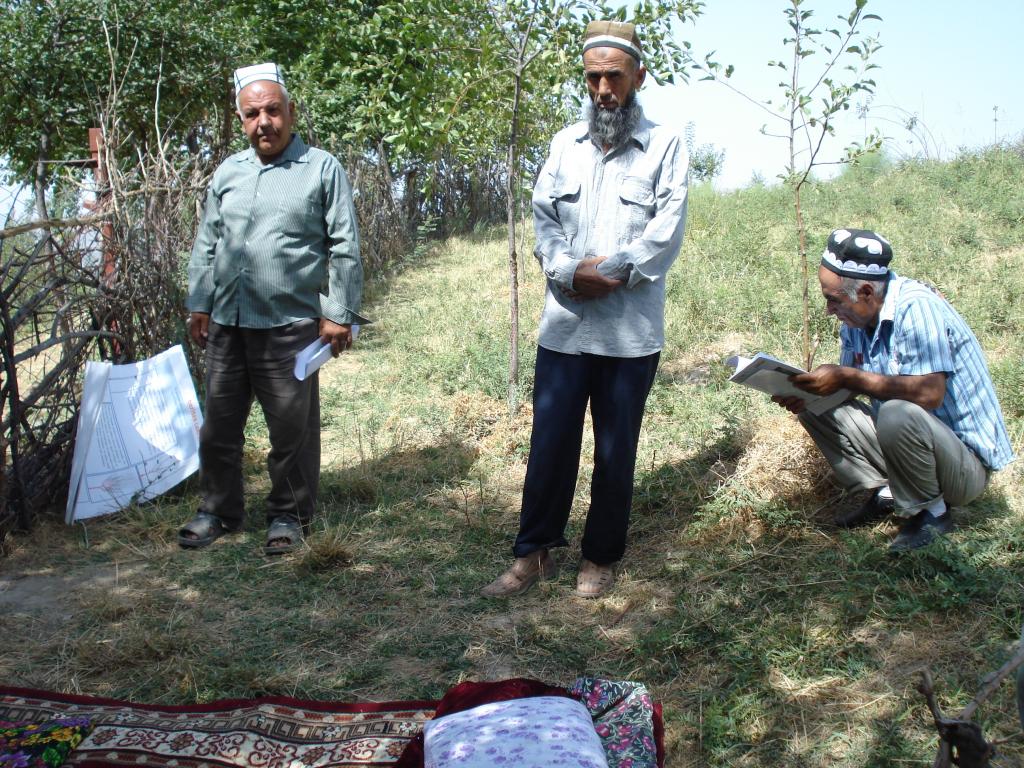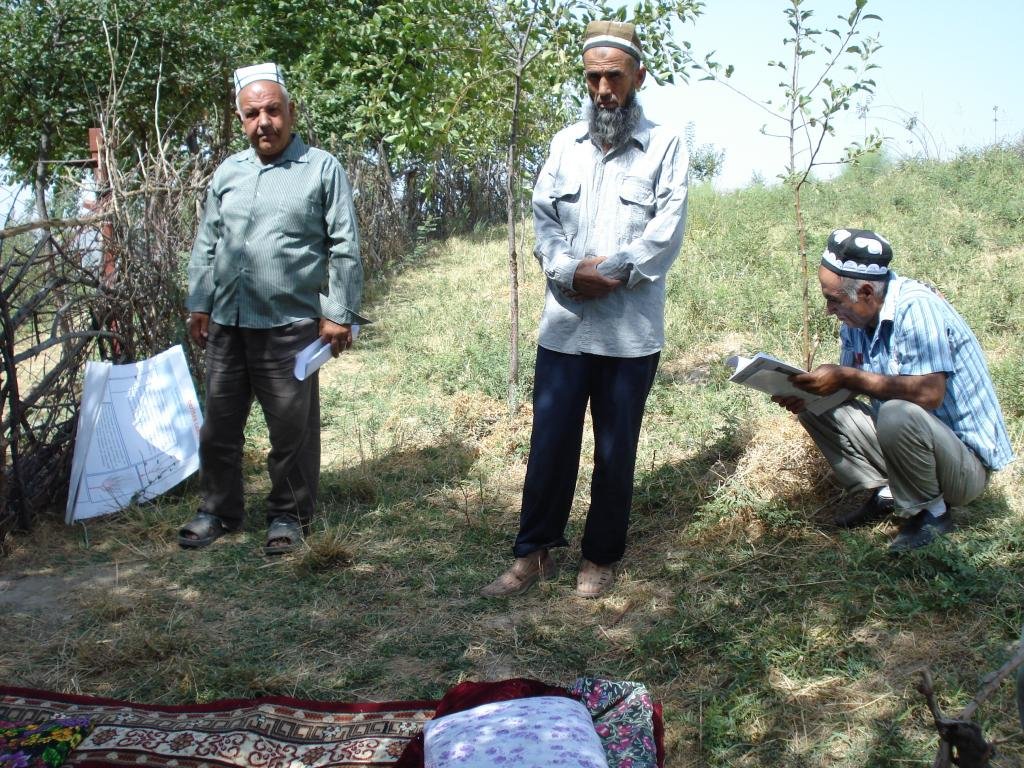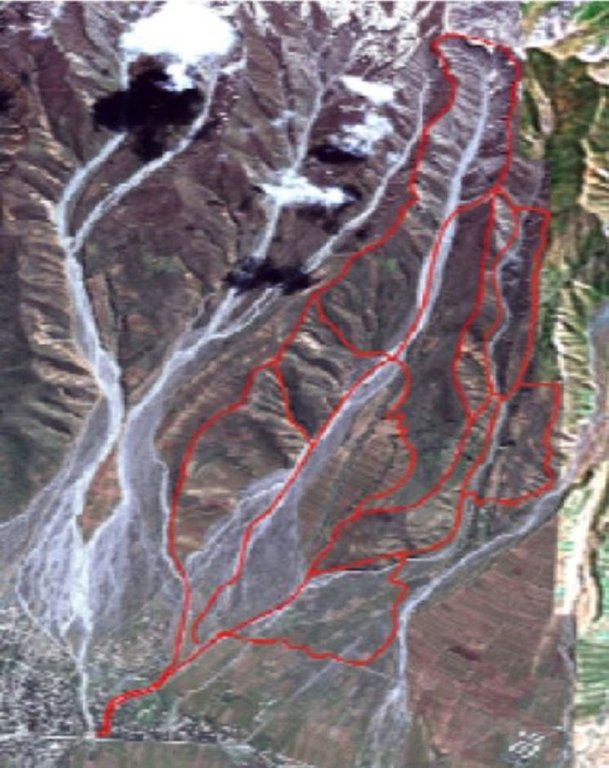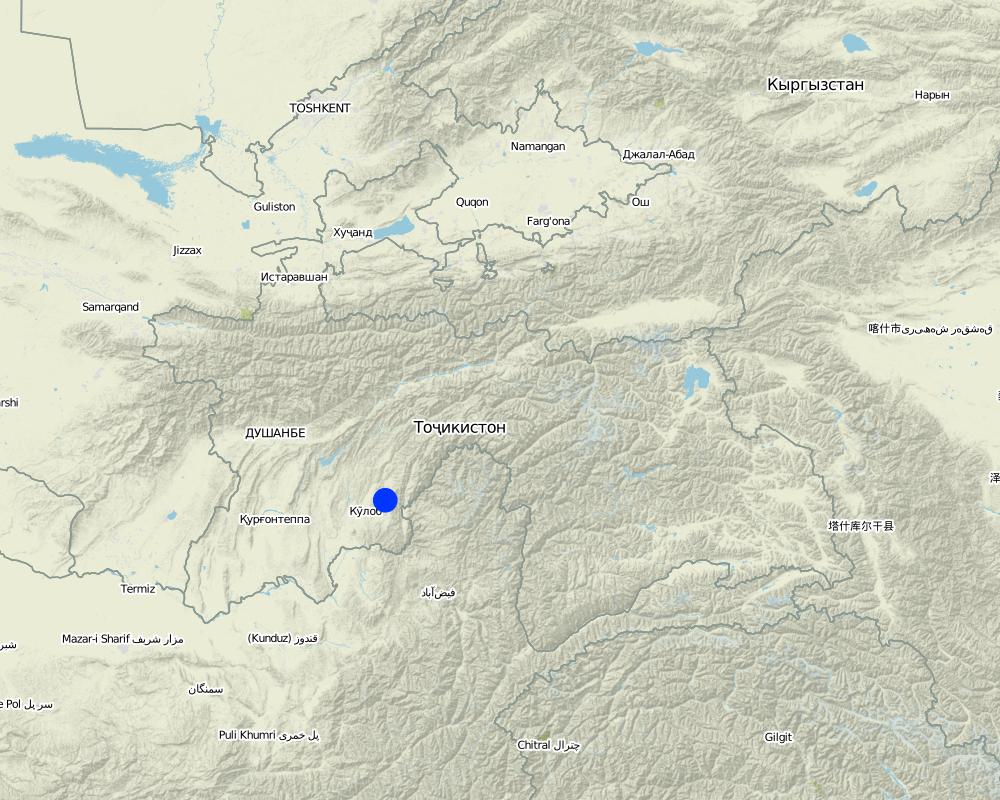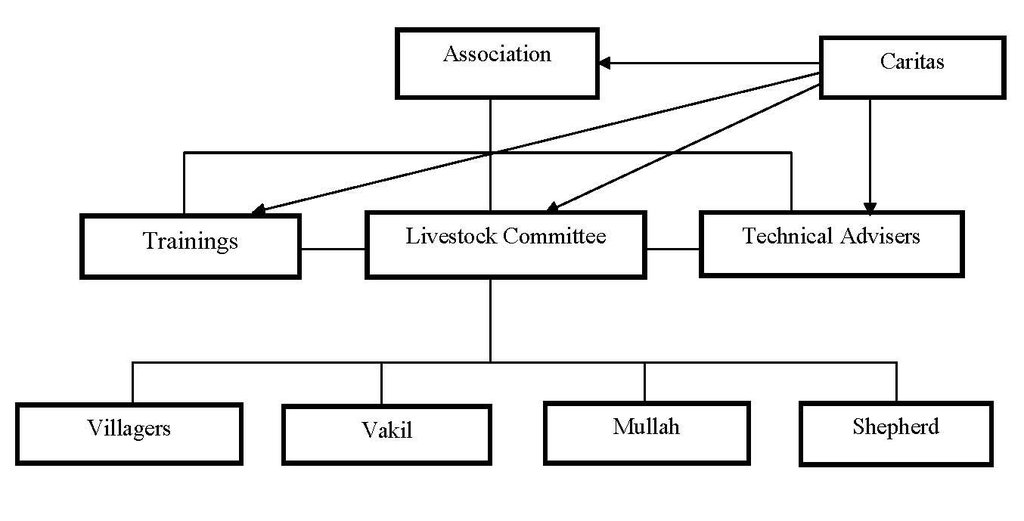Livestock Committee at Village Level [طاجيكستان]
- تاريخ الإنشاء:
- تحديث:
- جامع المعلومات: Sa'dy Odinashoev
- المحرر: –
- المُراجع: David Streiff
Кумитаи чорврдори дар сатхи деха
approaches_2435 - طاجيكستان
عرض الأقسام
توسيع الكل طي الكل1. معلومات عامة
1.2 تفاصيل الاتصال بالأشخاص الرئيسيين لمصدر المعلومات والمؤسسات المعنية بتقييم وتوثيق النهج
1.3 الشروط المتعلقة باستخدام البيانات الموثقة من خلال WOCAT
متى تم تجميع البيانات (ميدانيا)؟:
16/08/2010
يوافق جامع المعلومات والشخص (لاشخاص) الرئيسي لمصدر المعلومات على الشروط المتعلقة باستخدام البيانات الموثقة من خلال WOCAT:
نعم
1.4 المراجع الخاصة باستبيان(استبيانات) تقنيات الإدارة المستدامة للأراضي
2. وصف نهج الإدارة المستدامة للأراضي
2.1 وصف موجز للنهج
Livestock committees were established with the goal to improve livestock health as well as natural resource management in the watersheds where the village pastures were situated. Livestock committees in the Muminabad district are organised at village level and coordinate their activities through the registered livestock association at district level.
2.2 وصف تفصيلي للنهج
وصف تفصيلي للنهج:
Aims / objectives: This approach applied by Caritas Switzerland, aimed to improve natural resource management in the watersheds through an organised effort of livestock owners. It encourages preventive measures against soil erosion by providing incentives for beneficiaries at community level. The process is managed by the livestock committees, who represent the animal owners at village level. The committees are responsible for organising livestock owners and managing the village pastures by applying rotational grazing principles, establishment of water points and rest places, ensuring safe paths for animals and easy access to pasture lands.
Stages of implementation: The project encompasses the following steps: 1) Competitive call for project proposals to improve livestock and pasture management through villager's efforts, 2) Expression of interest from community members to participate in the competition, 3) Development of project proposals from villagers with assistance of technical staff from the implementing agency (Caritas), 4) Selection and notification of winners, confirmation of village funding commitments, 5) A village general meeting for the inception of project and laying the foundation for the livestock committee, 6) Formalisation of partnership agreement with donor (signed agreements for project implementation), 7) Project implementation transfer into livestock committee’s responsibility, 8) Technical assistance through training and workshops, monitored by the implementing agency (Caritas), 9) Strengthening of the livestock committee as a community based organisation, 10) follow up and continued activity of livestock committee through other projects and self organised activities among livestock owners.
Role of stakeholders: Various locals and village members are essential is assisting with the success of the project; The religious head (mullah) acts as a promoter of idea and mobilises the community through developing villager's interest; the village informal leader (vakil), helps to coordinate the activities; local organisations assist in informing and bringing people together for the meetings. The livestock committee consists of five members, including the appointed head shepherd. This has proven to be an effective size group. The main tasks of this committee include; mapping the pasture lands, organising rotational schemes, informing and training livestock owners of methods to improving pasture grazing, keeping villagers informed, establishing and collecting membership fees, keeping the accounts for the organisation, and application of funds (own or donor’s), develop new ideas and project proposals for further land improvement projects.
Other important information: The villagers are responsible for the labour contribution during the construction of water points or paths/roads. They pay membership fees, which cover the shepherd’s salary and the committee’s activities. They are kept informed of pasture grazing schemes, and control the performance of the committee.
2.3 صور عن النهج
2.5 البلد/المنطقة/المواقع التي تم تطبيق النهج فيها
البلد:
طاجيكستان
المنطقة/الولاية/المحافظة:
Khatlon
مزيد من التفاصيل حول الموقع:
Muminabad
Map
×2.6 تواريخ بدء وإنهاء تنفيذ النهج
أشر إلى سنة البدء:
2004
سنة الإنهاء (إذا لم يعد النهج مطبقًا):
2010
2.7 نوع النهج
- قائم على مشروع/برنامج
2.8 الغايات/الأهداف الرئيسية للنهج
The Approach focused mainly on SLM with other activities (Improve the health of livestock to water, safe roads to pasture and rest places)
To implement a responsible body to manage the common pasture land in the village, and improve conditions for livestock husbandry.
The SLM Approach addressed the following problems: Implementation of pasture projects and their sustainability. Little awareness and capacity in the field of sustainable pasture management among villagers, which hampers implementation of pasture projects.
2.9 الظروف التي تمكن أو تعيق تنفيذ التقنية/التقنيات المطبقة بموجب النهج
المعايير والقيم الاجتماعية /الثقافية/ الدينية
- معيق
hierarchical society, individual villagers wait for the religious or governmental leader to make decisions
Treatment through the SLM Approach: Livestock committee to coordinate with the leaders of the society
توفر/الوصول إلى الموارد والخدمات المالية
- معيق
no funds available to pay a herder
Treatment through the SLM Approach: monthly contributions from the villagers
الإطار المؤسساتي
- معيق
no formal organisation for management of the common pasture land at the village level
Treatment through the SLM Approach: village livestock committees
الإطار القانوني (حيازة الأراضي، وحقوق استخدام الأراضي والمياه)
- تمكين/تمكيني
The existing land ownership, land use rights / water rights greatly helped the approach implementation: common management of common land by the livestock committee
- معيق
unclear situation with regard to water use rights
Treatment through the SLM Approach: village negotiations are facilitated by Caritas Switzerland and the livestock committee
المعرفة حول الإدارة المستدامة للأراضي، والوصول إلى الدعم الفني
- معيق
limited access to technical knowledge regarding the setup of a water distribution system
Treatment through the SLM Approach: technical advice provided by specialists from Caritas Switzerland
عبء العمل، توفر القوى العاملة
- معيق
pasture improvement projects are too large for single people or families
Treatment through the SLM Approach: joint effort of the whole village
3. المشاركة وأدوار الأطراف المعنية
3.1 أصحاب المصلحة المعنيون بالنهج وأدوارهم
- مستخدمو الأراضي المحليون/المجتمعات المحلية
all community members are involved
everybody can participate, disadvantaged groups have equal access
- متخصصون في الإدارة المستدامة للأراضي / مستشارون زراعيون
international specialists
technical advisors are all male
- منظمة غير حكومية
3.2 انخراط مستخدمي الأراضي المحليين/المجتمعات المحلية في المراحل المختلفة للنهج
| انخراط مستخدمي الأراضي المحليين/المجتمعات المحلية | حدد من شارك وصف الأنشطة | |
|---|---|---|
| المبادرة/التحفيز | تفاعلي | Projects are elaborated by villagers with support of an international NGO |
| التخطيط | تفاعلي | village meetings, district meetings and proposal presentations |
| التنفيذ | الدعم الخارجي | Cost sharing is from 80:20 up to 50:50. The village contributes the work force, stones and seedlings. Pipes and knowledge are provided externally. |
| الرصد/التقييم | تفاعلي | members of the livestock committee and international NGOs |
| Research | غير موجود |
3.3 مخطط التدفق (إذا كان متاحًا)
الوصف:
This organisational chart shows how the approach works at village level.
المؤلف:
Sady Odinashoev (Muminabad, Tajikistan)
3.4 اتخاذ القرار بشأن اختيار تقنية/تقنيات الإدارة المستدامة للأراضي
حدد من الذي قرر اختيار التقنية/التقنيات التي سيتم تنفيذها:
- متخصصون في الإدارة المستدامة للأراضي بشكل أساسي، بعد التشاور مع مستخدمي الأراضي
اشرح:
Decisions on the method of implementing the SLM Technology were made by mainly by SLM specialists with consultation of land users
4. الدعم الفني وبناء القدرات وإدارة المعرفة
4.1 بناء القدرات/التدريب
هل تم تقديم التدريب لمستخدمي الأراضي / الأطراف المعنيين الآخرين؟:
نعم
حدد من تم تدريبه:
- مستخدمو الأراضي
شكل التدريب:
- من مزارع إلى مزارع
- مناطق العرض
- اجتماعات عامة
المواضيع المغطاة:
Training in pasture management, rotational grazing, natural resource management and soil erosion.
4.2 خدمة استشارية
هل يملك مستخدمو الأراضي وصولا إلى خدمة استشارية؟:
نعم
حدد ما إذا كانت الخدمة الاستشارية متوفرة:
- في حقول مستخدمي الأراضي
وصف/تعليقات:
Key elements: theoretical and practical workshop, monitoring visits
Advisory service is quite adequate to ensure the continuation of land conservation activities; Government and other advisory service are now quite adequate to ensure the continuation of land conservation activities. The government saw the examples of good pasture management and is interested to continue with such approaches in collaboration with the livestock association.
4.3 تعزيز المؤسسات (التطوير التنظيمي)
هل تم إنشاء أو تعزيز مؤسسات من خلال هذا النهج؟:
- نعم، إلى حد كبير
حدد المستوى (المستويات) التي تم فيها تعزيز أو إنشاء المؤسسات:
- محلي
حدد نوع الدعم:
- بناء القدرات/التدريب
اعط مزيدا من التفاصيل:
There were trainings for this Approach
4.4 الرصد والتقييم
هل يشكل الرصد والتقييم جزءا من النهج؟:
نعم
التعليقات:
technical aspects were regular monitored by project staff through observations; indicators: water distribution system
management of Approach aspects were ad hoc monitored by project staff through observations; indicators: participation in committee meetings
pasture rotation aspects were regular monitored by project staff through observations; indicators: daily observations by the shepherd from the livestock committee
There were no changes in the Approach as a result of monitoring and evaluation: None
There were few changes in the Technology as a result of monitoring and evaluation: small changes on the road construction
4.5 البحوث
هل كانت البحوث جزءًا من النهج؟:
كلا
5. التمويل والدعم المادي الخارجي
5.1 الميزانية السنوية لمكون الإدارة المستدامة للأراضي في النهج المذكور
إذا لم تكن الميزانية السنوية الدقيقة معروفة، قم بالإشارة إلى نطاقها:
- 10,0000-2,000
التعليقات (على سبيل المثال المصادر الرئيسية للتمويل/الجهات المانحة الرئيسية):
Approach costs were met by the following donors: International (seminars, workshops, meetings): 80.0%; local community / land user(s) (worktime, providing meeting place): 20.0%
5.2 الدعم المالي/المادي المقدم لمستخدمي الأراضي
هل حصل مستخدمو الأراضي على دعم مالي/ مادي لتنفيذ التقنية/ التقنيات؟:
نعم
إذا كانت الإجابة بنعم، حدد نوع (أنواع) الدعم والشروط والمزودين:
Labour input by land users was rewarded with pipes, maps and technical support
5.3 إعانات لمدخلات محددة (بما في ذلك العمالة)
- معدات
| حدد المدخلات التي تم دعمها | إلى أي مدى | حدد الإعانات |
|---|---|---|
| أدوات | shovel, spades provided by village | |
- زراعة
| حدد المدخلات التي تم دعمها | إلى أي مدى | حدد الإعانات |
|---|---|---|
| seedlings | from household gardens | |
- بناء
| حدد المدخلات التي تم دعمها | إلى أي مدى | حدد الإعانات |
|---|---|---|
| حجر | collected from field | |
- بنى تحتية
| حدد المدخلات التي تم دعمها | إلى أي مدى | حدد الإعانات |
|---|---|---|
| طرق | ممول بالكامل | |
| pipes | ممول بالكامل | |
إذا كان العمل من قبل مستخدمي الأراضي مدخلاً جوهريًا، فهل كان:
- مقابل دعم مادي آخر
5.4 الائتمان
هل تم توفير ائتمان في إطار نهج أنشطة الإدارة المستدامة للأراضي؟:
كلا
5.5 حوافز أو وسائل أخرى
هل تم استخدام حوافز أو أدوات أخرى لتشجيع تنفيذ تقنيات الإدارة المستدامة للأراضي؟:
نعم
إذا كانت الإجابة بنعم، حدد:
There were trainings for this Approach for local institutions
6. تحليل الأثر والتصريحات الختامية
6.1 آثار النهج
هل ساعد النهج مستخدمي الأراضي على تنفيذ وصيانة تقنيات الإدارة المستدامة للأراضي؟:
- لا
- نعم، قليلا
- نعم، باعتدال
- نعم، إلى حد كبير
The soil cover improved, the milk production increased and the cows became fatter and healthier.
هل ساهم النهج في تمكين الفئات المحرومة اجتماعيا واقتصاديا؟:
- لا
- نعم، قليلا
- نعم، باعتدال
- نعم، إلى حد كبير
Everybody is benefitting in the same way.
هل أدى النهج إلى تحسن في مسائل حيازة الأراضي / حقوق المستخدمين التي أعاقت تنفيذ تقنيات الإدارة المستدامة للأراضي؟:
- لا
- نعم، قليلا
- نعم، باعتدال
- نعم، إلى حد كبير
livestock committee negotiated access to water
Did other land users / projects adopt the Approach?
- لا
- نعم، قليلا
- نعم، باعتدال
- نعم، إلى حد كبير
But other organisations and the government have shown interest in these ideas.
Did the Approach lead to improved livelihoods / human well-being?
- لا
- نعم، قليلا
- نعم، باعتدال
- نعم، إلى حد كبير
Improvement in pastures, and milk production. Livestock has high importance as it is a large financial investment.
Did the Approach help to alleviate poverty?
- لا
- نعم، قليلا
- نعم، باعتدال
- نعم، إلى حد كبير
With this Approach the cows become heavier and produce more milk. These animals then achieve higher prices on the market.
6.2 المحفز الرئيسي لقيام مستخدمي الأراضي بتنفيذ الإدارة المستدامة للأراضي
- زيادة الإنتاج
milk, meat
- زيادة الربح (القدرة)، وتحسين نسبة التكلفة إلى العائد
better food, less distance to walk for the animals
- انخفاض عبء العمل
6.3 استدامة أنشطة النهج
هل يمكن لمستخدمي الأراضي المحافظة على استدامة ما تم تنفيذه من خلال النهج (بدون دعم خارجي)؟:
- نعم
إذا كانت الإجابة بنعم، صف كيف:
The committee and collaboration among different stakeholders are well organised and the committee is now working independently. Financial contributions per villager are quite low and villagers are willing to increase them in the future if required.
6.4 نقاط قوة/مزايا النهج
| نقاط القوة/ المزايا/ الفرص من وجهة نظر مستخدمي الأراضي |
|---|
| financial contributions of each village household creates ownership (How to sustain/ enhance this strength: Financial contributions per villager are low and can be afforded also by poor households. This assures ongoing contributions.) |
| نقاط القوة/ المزايا/ الفرص من وجهة نظر جامع المعلومات أو غيره من الاشخاص الرئيسيين لمصدر المعلومات |
|---|
| workshops in the villages (How to sustain/ enhance this strength: The livestock committees are integrated in an association and this will assure continued access to information.) |
6.5 نقاط الضعف/ العيوب في المنهج وطرق التغلب عليها
| نقاط الضعف/ المساوىء/ المخاطر من وجهة نظر جامع المعلومات أو غيره من الاشخاص الرئيسيين لمصدر المعلومات | كيف يمكن التغلب عليها؟ |
|---|---|
| Less participation of the women in the workshops | To explain to the men that women should also attend. |
7. المراجع والروابط
7.1 طرق جمع/مصادر المعلومات
- زيارات ميدانية، مسوحات ميدانية
- مقابلات مع مستخدمي الأراضي
الروابط والوحدات المواضيعية
توسيع الكل طي الكلالروابط
لا يوجد روابط
الوحدات المواضيعية
لا يوجد وحدات مواضيعية


